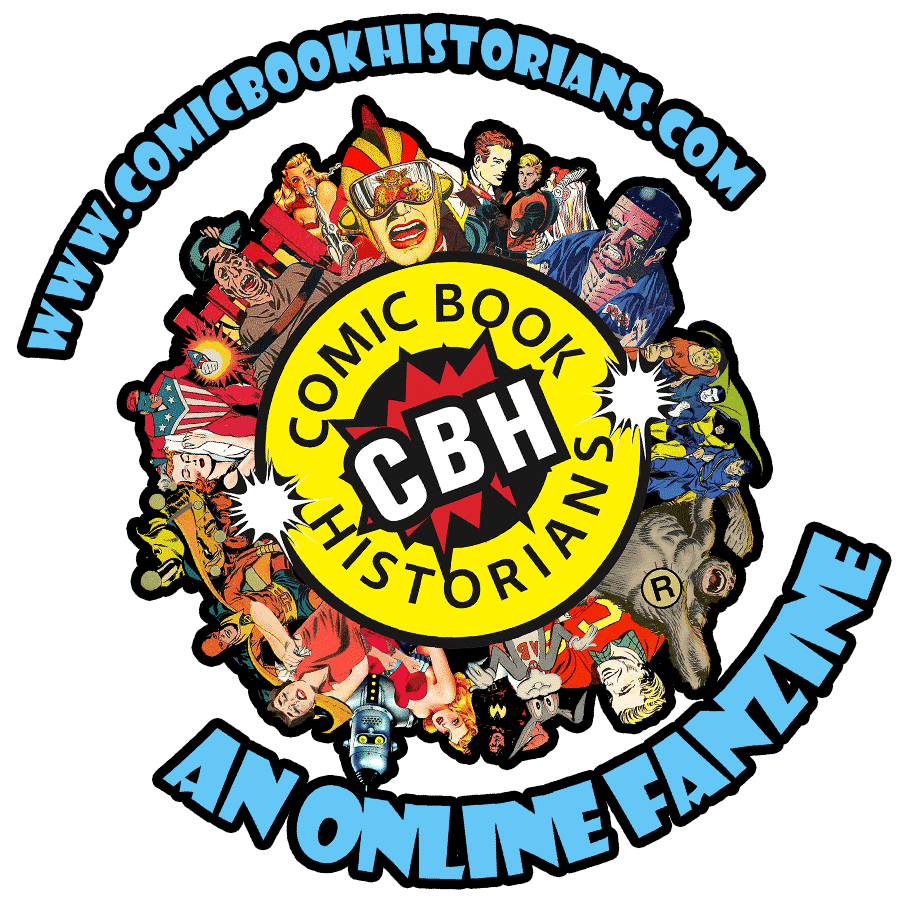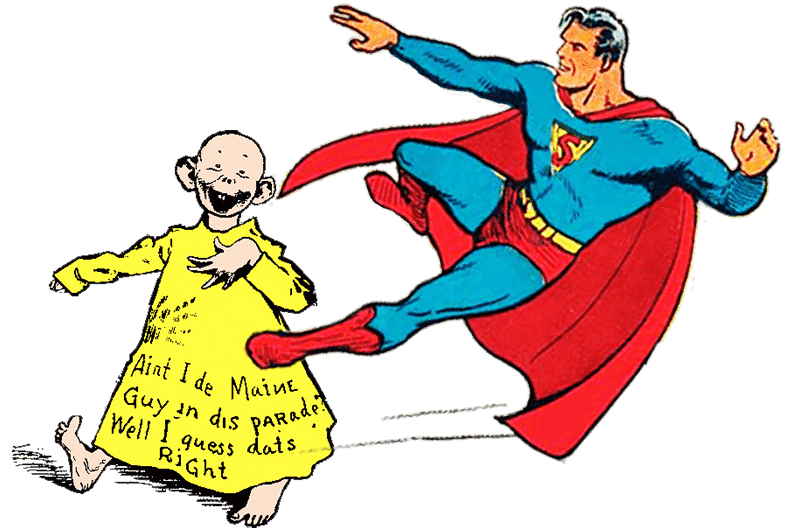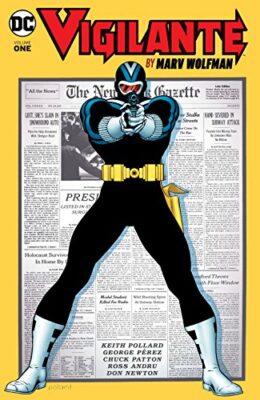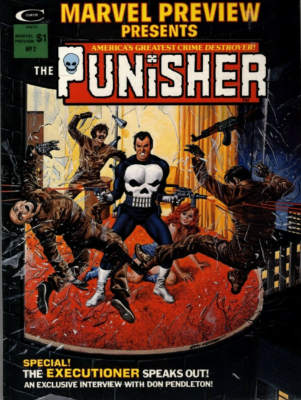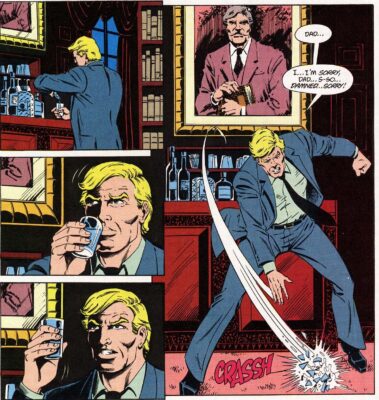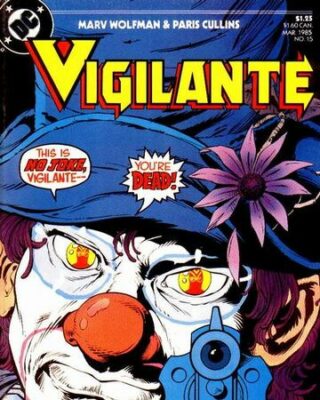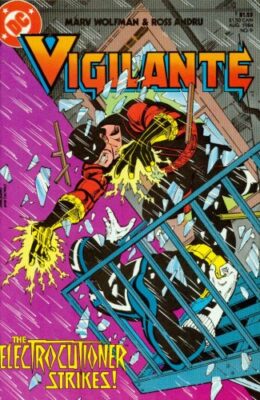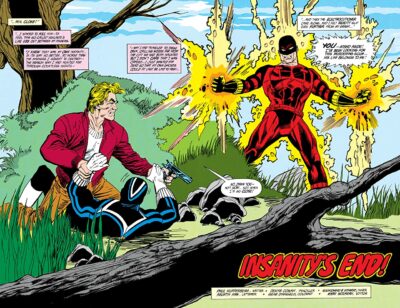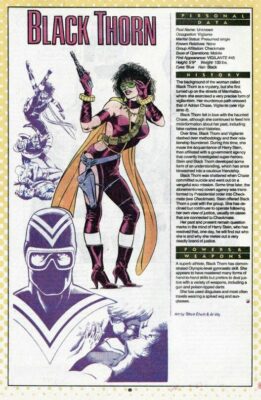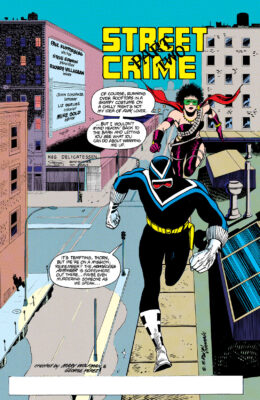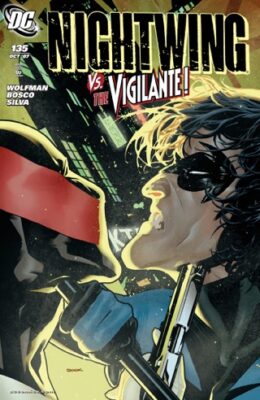Vigilante Walks the Tormented Path to the Final End by Anthony Caro
Created by Marv Wolfman and George Perez and debuting in Teen Titans, Vigilante, the violent alter ego of NYC District Attorney and later Judge Adrian Chase, remains a curious character from the 1980s.
Excellent writing from Wolfman, Alan Moore, and Paul Kupperberg, however, could not help the character escape the obvious: Adrian Chase/Vigilante was DC Comics’ version of the “original” vigilante, Marvel Comics’ Frank Castle/The Punisher. A long-standing inability to escape The Punisher’s shadow keeps Vigilante from rediscovery and appreciation. Vigilante #1 (November 1983) also landed a decade too early. Had the book arrived when The Punisher and Wolverine took violent characters to the top of sales charts, the original Vigilante might have been a hit, as the writing and storylines were more dimensional than most pre-Marvel MAX Punisher tales. In the 1980s, Vigilante, the series, didn’t catch fire.
Today, the book maintains a minor cult following due to the series’ finale in which a traumatized and psychologically broken Adrian Chase takes his own life. While shocking, the ending did not come without a setup. Key story points in various preceding issues scripted brilliantly by Kupperberg show a sharp decline in Chase’s mental state. Issue #50 shocked readers because heroes, anti or otherwise, don’t kill themselves. Things were different here. Adrian Chase’s decision to become a vigilante killer led him to the seemingly inescapable path of ruin and self-destruction.
And the dark conclusion follows several warning signs. Chase’s guilt and trauma increase slowly throughout the final two years of the series. The ending delivers dramatic resonating power due to the narrative’s construction – we don’t see it coming, but we should have. The tragic end of Adrian Chase comes after a progressive decline chronicled from one storyline to the next.
Vigilante: Not Your Average Punisher Type
Calling Vigilante a Punisher knock-off is unfair. Some differences do exist between Vigilante and The Punisher. Frank Castle both shared a nearly identical origin story, but Castle became a loner while Chase attempted to live an everyday life outside of his Vigilante persona. No real distinctions exist between Frank Castle and The Punisher. Why does Castle even use the alternative name? (Chase would eventually fully erase differences between himself and the Vigilante persona towards the series’ end.)
Another critical psychological point separated Vigilante from The Punisher. The Punisher lost his grip on sanity right after his family’s murder. While disturbed, The Punisher (mostly) maintained a level of stability. Vigilante’s family’s murder drove him to take revenge on criminals, but he did not appear to become a mistanthropic sociopath. Eventually, the character grew more and more disturbed until his mental state drastically declined. At times, Chase/Vigilante seemed to be stable but continually seeing friends and loved ones die accelerated a downward spiral leading to suicide.
The last third of the series plays a slow march to the demise of Adrian Chase. The reader can’t help but notice Chase’s descent into despair. As the storylines progress, the tales become grittier. And the exposure to violent elements continues to wear away at Adrian Chase’s mental state. And Chase knows he needs to get out. As much as Chase wants to give up being Vigilante, he can’t, increasing the unrelenting trauma.
There exists another critical difference between The Punisher and Vigilante: Frank Castle embraces what he has become and never walks away. Adrian Chase repeatedly wants to walk away. He can’t. And he should. Castle coldly accepts becoming The Punisher while Adrian Chase never appears comfortable as Vigilante. He knows he shouldn’t be doing what he does. Ironically, giving up the mask makes things even worse for Chase.
No Peace for Vigilante
Adrian Chase did self-reflect enough to realize turning into a murderous “hero” comes with a price. Walking away seemed to be a wise choice, but retiring only opened doors for others to take up the Vigilants mantle with disastrous consequences. The erratic and dangerous Alan Wells’ turn as Vigilante led to his demise. The same turned out true for the naïve Dave Winston.
Dave Winston assumed the role of Vigilante with the absurd decision to rehab the tarnished antihero’s name. Winston donned the Vigilante costume with the plan to use his (marginal) skills less violently.
Dave Winston tragically crossed paths with The Peacemaker, a psychotic vigilante who suffers from paranoia-induced hallucinations. The Peacemaker’s willingness to kill stretches beyond acceptable bounds. Peacemaker kills a non-threatening Winston in front of Adrian Chase, leading to Chase’s return as Vigilante.
“Some things are inevitable…inescapable….and the only way to get around it is through death.”
Adrian Chase utters these words in Vigilante #36 (December 1986) right after Winston dies in a hail of The Peacemaker’s gunfire, and Chase realizes he can’t escape his lot in life: he’s Vigilante.
What “death” does he refer to here, though? Surface-wise, the reader assumes Chase believes you can only escape your destiny in life when life ends. Such a sentiment hints at where the series heads: to the eventual death of Adrian Chase.
And there’s also an irony to the state that someone can get around things through death. Chase not only hints of his own death, but he’s also implying, whether knowingly or not, he brings death to others. Chase seeks to correct the inevitable, inescapable evils of men by killing them. The trouble here is Chase’s path also contributes to significant collateral damage.
Adrian Chase’s mental sanity also slowly dies with each escapade of vigilantism. Chase remains filled with guilt over the multiple deaths of loved ones who died due to his “fault.” Living a violent life has its consequences, and Chase isn’t immune. Furthermore, each escapade exposes him to the criminal world’s darker underbelly and slowly tears Chase’s sanity away.
Winston’s death becomes the triggering incident where Chase starts a dangerous and self-destructive descent into obsessive killings. To further justify killing criminals, he must seek out those who “deserve” vigilante justice the most, such as the child sex traffickers in issues 39 (March 1987) and 40 (April 1987). Exposure to these vile criminals further drives him over the edge.
How could the mind not continue to suffer after continually dealing with such a dark side of humanity while accepting the guilt of taking human lives?
When seeking out the child slavers, Vigilante becomes desperate and does something he hadn’t previously: he tortures a suspect to give up information. The line crossed here indicates a character who’s losing his grip and becoming more erratic and psychotic.
And there’s a not-so-subtle turning point here: Chase admonishes partner Stein when he calls him by Chase’s real name. The former Adrian Chase responds he’s just “Vigilante” now. Adrian Chase “dies” and becomes the singular of Vigilante. The previous distinction between Chase/Vigilante and Frank Castle/The Punisher undergoes erasure.
Eliminating Chase and embracing the caricature of Vigilante allows Chase to symbolically kill himself and allows his humane side to die. Perhaps the hope here is to eliminate the part of him that feels guilt. The strategy doesn’t work.
Prelude to a Descent
Preludes to Chase’s psychotic decline appear as hints in earlier issues.
Issue #36 (December 1986) repeats sentiments mentioned in issue #33 (September 1986), “I lost everyone….everyone who ever cared for me. Or who I cared for….All dead. Destroyed by my obsessions and madness. God. I’ve done so much more harm than good in my life. How did it all go so wrong? I’m so tired of all the death and grief…But it keeps following me everywhere.”
In the same issue, Vigilante walks past a female police officer who almost fell victim to a rapist. Vigilante returns her gun, revealing that she has “two shots left.” He walks away, indicating he won’t struggle. Was Chase attempting “suicide by cop?”
At this point, we don’t assume so because the character hasn’t yet become unhinged. However, subtle indications that Chase’s moving in the “unhinged direction” gradually become less subtle.
Adrian Chase’s earlier incarnations existed somewhere in between Batman and the homicidal vigilante villains. Chase crosses the line Batman will not cross: he kills. Chase also won’t hurt people who don’t deserve it, or does he? Issue #37 (January 1987) shows Chase willing to shoot a police officer to “merely” wound him to make an escape. How does Chase know the police officer won’t bleed to death, die from complications, or otherwise suffer a fatality?
Distinctions exist between Adrian Chase and The Peacemaker and The Electrocutioner, as well as the Alan Wells version of Vigilante. Those distinctions slowly decline. Perhaps the moral here is there’s only one kind of Vigilante. We can’t even say Vigilante is a sympathetic character as we gradually lose sympathy for him. When playing off the other vigilantes, the title “hero” becomes self-righteous, giving us insights into his disturbing nature.
Is there self-projection here? Does Vigilante “hate” these characters because they are a reflection of him? Or does he see himself as special and righteous, and other vigilantes take away from his “special” nature?
Irony exists when Vigilante compares himself to The Peacemaker when saying, “….almost as good as me….but he was crazy,” and noting during his lethal battle against terrorists, “…only now do I feel alive.”
Adrian Chase may define “special” in terms of “righteous” and “justice.” By the conclusion of the series, the word takes on meaning more akin to narcissistic and psychopathic.
Issue #42 (June 1987) reveals Chase exacting poetic justice on someone who beats up “little old ladies” for the lottery winnings: Chase attempts to beat the man to death. Such actions were not the modus operandi of Vigilante in earlier issues, and his behavior continues to appear more erratic and out of control.
Issue #44 (August 1987) also shows Chase embracing a harsh tactic – beating crooks to get information on the drug trade. Again, such behavior would be unheard of in the earlier issues and not in the Teen Titans’ appearances.
Can’t Find A Way Home
The two-part “Homeless Avenger” story arc in issues #48 (December 1987) and #49 (January 1988), the prelude to the final issue, reveals a conflicted Adrian Chase.
Ironically, issue #47 (November 1987) saw Vigilante/Chase “die” during a confrontation with Batman. Chase doesn’t die, though. Batman provides a credible cover story that Chase met his demise, giving Chase an out: he can let the world believe he’s dead and start over, leaving Vigilante behind.
Of course, nothing of the sort happens. Chase returns to the Vigilante costume and teams with his new partner and paramour, Black Thorn, to hunt down The Homeless Avenger, a vigilante dedicated to protecting the homeless by murdering those who accost them.
The Homeless Avenger comes off as a brutal savior who delivers final justice against would-be muggers and rapists of New York’s homeless. Seeing him as a hero disappears when, in a redux of Alan Wells’ misguided violence, The Homeless Avenger kills a police officer to protect an unstable and armed elderly homeless man.
Chase calls off his search for The Homeless Avenger after meeting with several homeless people the ski mask-wearing vigilante protects. Chase feels empathy towards The Homeless Avenger and chooses to ignore the police officer’s shooting. Chase muses about how he wished he had someone to look over him, like the homeless people he met do.
Black Thorn, however, is not moved. She goes after The Homeless Avenger, which puts her on a collision course with lover Chase. Black Thorn brutally accosts several homeless people to locate the whereabouts of The Homeless Avenger, and Chase blames himself for her actions:
“I pitied myself…That I could become the man I had, allowing myself to spread my twisted gospel to another.”
Adrian Chase, Vigilante, sees Black Thorn’s brutality as his fault as if his very being is a contagion. Chase can no longer hold back his self-loathing. Self-hatred appears ingrained in all his thoughts, and now he tries to contain the damage he believes he caused.
Chase is not responsible for Black Thorn’s actions. She’s disturbed, and she would remain a disturbed person had she never met Adrian Chase. No matter. Chase’s guilt now manifests as a self-persecution complex, and he’s carrying that guilt for things that are not even his fault.
Eventually, Chase catches up with Black Thorn and delivers a thrashing to keep her from killing The Homeless Avenger. Yet, when a mob descends on The Homeless Avenger, Chase asks him if he needs help, and The Homeless Avenger declines. Chase inexplicably leaves The Homeless Avenger to the crowd and his fate.
Chase notes, although the call was The Homeless Avenger’s, “I was the one who would have to live with his decision.” Again, Chase intends to accept blame and guilt. He continues to see himself as the problem.
All the characters lose their perspectives in this two-parter. Black Thorn becomes obsessed with killing The Homeless Avenger because he killed several criminals. Vigilante attacks Black Thorn to save The Homeless Avenger, allowing the Avenger to get beaten to death. No one thinks clearly here, and the chaos of the story’s end reveals both vigilantism and chaos become inseparable.
Chase/Vigilante finds one way to make sense of the chaos: he sets himself up to explain why everything goes wrong. Chase sees his role as the common thread among all chaotic and unfortunate events. Self-blame leads to self-hatred and self-inflicted death.
The Vigilante Road Leads to Nowhere
Vigilante #50 (February 1988) proved incredibly shocking for its time, as comic book “last issues” never ended so final nor as nihilistic. The series did not end with Adrian Chase throwing away the costume and walking off to parts unknown and future guest appearances in other books. Nor was his death an ambiguous one, such as an explosion or plane crash. No reader sat wondering, “Did Vigilante survive?” Adrian Chase put a .44 Magnum under his chin and pulled the trigger.
The Homeless Avenger’s death triggers Chase to question his actions verbally. Chase realizes that his anger and rage over his wife and children’s murder control him. Earlier beliefs that Vigilante came into existence to bring justice reflect self-delusion. Vigilante is a killer, and Vigilante represents Chase’s uncontrolled rage and anger. Vigilante creates the proverbial fig leaf for Chase to lash out. The uncontrollable nature of lashing out tends to harm others indiscriminately, and that drives Chase’s guilt.
Chase’s final crusade sees him attempt to get himself killed while hunting down criminals. He only ends up hurting more innocent victims. And Chase concludes he’s the only person capable of taking out the “killer” known as Vigilante.
As the afterword in the final issue put it, “He had become the evil that he was fighting.” In his own eyes, Adrian Chase’s suicide is self-directed vigilantism snd a bitter, tragic series conclusion.
(The afterword also points out suicide is never the answer, a thoughtful reminder to readers.)
Anthony Caro writes about all things pop culture and contributed to HorrorNews.Net, PopMatters, Mad Scientist, Jiu-Jitsu Times, and more. Besides working as a professional ghostwriter, he handled production duties in radio, TV, film, and theater.
essay ©2023 Anthony Caro
Join us for more discussion at our Facebook group
check out our CBH documentary videos on our CBH Youtube Channel
get some historic comic book shirts, pillows, etc at CBH Merchandise
check out our CBH Podcast available on Apple Podcasts, Google PlayerFM and Stitcher.
Use of images are not intended to infringe on copyright, but merely used for academic purpose.
Images used ©Their Respective Copyright Holders
